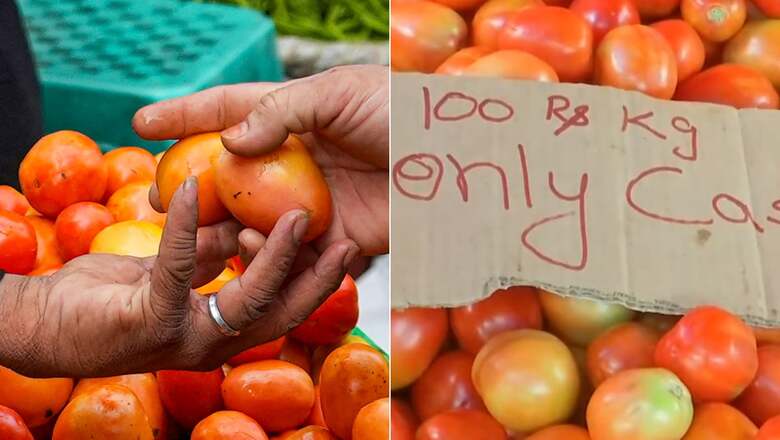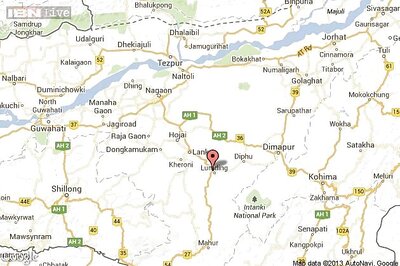
views
As Indians enjoy the delayed rain, the downpour hasn’t had a cooling effect on the vegetables as they are now set to burn holes in the pocket of a common man. Among them, tomatoes have topped the charts with its prices touching Rs 80-110 per kg in most of the states.
In Mumbai, the price of the kitchen essential reached an astronomical Rs 80-110 per kg in parts of the city, while Delhi is witnessing tomato prices hitting between Rs 80 and Rs 100.
The prices of the kitchen staple have seen a spike across the country, with tomato selling for Rs 100-120 per kg in Bengaluru, Rs 90-100 in Mysuru, Rs 40-50 in Kolkata, and Rs 100 in Chennai.
In Uttar Pradesh’s Kanpur, the wholesale price of tomatoes range from Rs 80-90 per kg and retail shops are selling it at Rs 100 per kg. News agency ANI quoted vegetable vendors as saying that tomatoes come to the city from Bengaluru and rain has disrupted the supply.
There has been a significant disruption in supply of tomatoes in the southern state’s district like Bengaluru Rural, Chitradurga, Chikkaballapur, Kolar and Ramanagara. A trader in Kanpur predicted that the prices can shoot up to Rs 150 per kg in the coming days.
A report in Times of India quoted wholesale and retail vegetable sellers as saying that the price of tomato has increased by almost 400% in the last three weeks, impacting household budgets.
The new crop from central and south India is expected in 7-10 days, and vegetable traders said the price may start dropping from the middle of the next month if the monsoon does not impact transportation, the report stated.
They, however, added that there were reports of rain damaging crops in some parts of the country, so the prices of other vegetables may start rising.
Climate Change and Crop Destruction
A report in Hindustan Times quoted Ashok Kaushik, president of Tomato Traders Association (TTA) at Delhi’s Azadpur Mandi, as saying that a majority of national capital’s tomato supplies between March to June comes from Haryana, Rajasthan, and Uttar Pradesh. However, unseasonal spells of rain throughout May and the early onset of the monsoon led to the tomato crop failing in these states, hampering supplies.
A report in Indian Express explained that the reason for the current high prices can be traced back to their sudden fall in April-May, which led many growers to abandon their crops. The unusual heat of March and April also saw pest attacks that took a toll on production.
India’s agricultural belt is the most sensitive sector when it comes to climate change. The main reason for this is the nature and characteristics of vegetation and crops being determined by the climate of a region or country.
A study, ‘Impact of Climate Change on Vegetable Crops and its Mitigation’, has stated that under changing climatic situations, crop failures, shortage of yields, reduction in quality and increase in pest and disease problems are common and they render the vegetable cultivation unprofitable.
The study explains how climate change can affect the suitability and adaptability of a crop by altering the growing period and affecting the quality as the high temperature and moisture stress increases sunburn and cracking in tomato, capsicums and other vegetables.
According to Carbon Impacts, high temperatures interfere with floral bud development due to flower abortion. This can cause significant losses in tomato productivity due to reduced fruit set, and smaller and lower quality fruits. In addition, significant inhibition of photosynthesis occurs at temperatures above optimum, resulting in considerable loss of potential productivity.
Low temperatures (decreases to 8-12°C) also have a significant impact on the tomatoes as it reduces seed germination and growth speed of pollen tube and the percent of fruit set of the kitchen staple.
Flooding is another crop destroyer as it affect the growth and yield in low lying rain fed areas. The main cause of damage under water logging is oxygen deprivation which affects nutrient and water uptake so the plants show wilting even when surrounded by excess water.
Lack of oxygen shifts the energy metabolism from aerobic mode to anaerobic mode. Flooded crops especially in tomato plants accumulate endogenous ethylene that causes damage to the plants, the report stated.
According to Carbon Impacts, salt stress also causes changes in a range of metabolic processes. In mature tomato fruit the amount of sucrose and the activity of sucrose phosphate synthase increased while fruit yield decreased under saline conditions. High salt concentration also causes an ionic imbalance and osmotic shock to tomato plants.
Soaring Prices of Other Vegetables in Festive Season
While ginger continues to remain expensive in both financial and national capitals for nearly two months, the two-month-long saawan and the three-day feast of Eid ul’ Zuha may be impacted due to the prices of the vegetables.
Amid the festive season, rates of other items have escalated too. A report in Times of India stated that in Mumbai, ginger stings at Rs 250-280 per kg, coriander is Rs 100 per big bunch, green chillies Rs 200/kg and French beans stand at Rs 180-200.
Steps Taken by Government
Tamil Nadu’s minister food and consumer protection department on Wednesday announced that in order to provide relief to the poor and middle-class people, tomatoes will be sold at Farm Fresh Outlets (FFOs) across Tamil Nadu to control prices. Tomato will be sold at Rs.68 per kg in FFOs. Steps are also being taken to sell tomatoes at Rs 60 per kg in FFOs, he added.
Tomato Alternatives
While avoiding tomatoes in some recipes may alter the taste of the dish, but for other cuisines and kitchen use, there are many options that people can choose from amid the soaring prices. This includes curd or yogurt, vinegar and tamrind.
CHECK FULL LIST & USES HERE | Here are the Best Alternatives to Tomato You Can Use for Your Dishes
People can also try and make tomato puree by adding sugar, salt and vinegar and freezing it. By adding vinegar, the longevity of the puree increases, making it fit to be consumed for three to six months. Several videos on the same are available on YouTube.



















Comments
0 comment